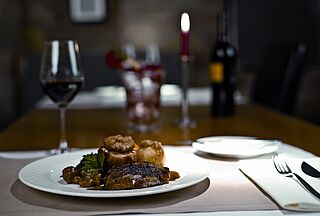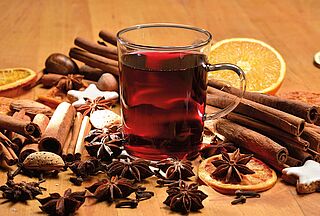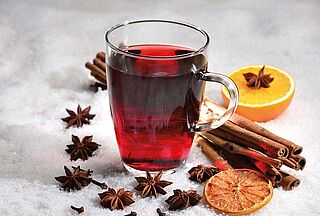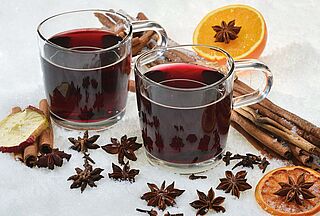Gaens
Kendte vinmarker
Ganz Gäns! Goose Galore!
December marks the opening of Germany's traditional outdoor Christmas markets – many of which are centuries old. Thousands of lights throughout the market places brighten the shortest days of the year and the air is filled with the spicy fragrance of Glühwein (hot, mulled wine) and Lebkuchen (gingerbread) as well as the scents of roasted chestnuts or grilled sausages and potato pancakes.
Another traditional culinary highlight of the season – from 11 November until Christmas – is Gänsebraten (roast goose). Its “vinous counterpart” stems from the Terrassenmosel vineyard Gäns (literally, geese) in Kobern-Gondorf, one of the steep, terraced sites some 17 km/11 miles south of the confluence of the Mosel with the Rhine at Koblenz.The lower stretch of the Mosel is home to some of the region’s most dramatically steep sites – where Riesling vines thrive in thin, stony, heat-retaining and mineral-rich soils underpinned by various layers of weathered slate, quartzite and graywacke. As the name Terrassenmosel implies, many vines are planted on precariously steep terraces that dictate vineyard maintentance and harvesting by hand – although the installation of monorails has helped lighten many a burden. Not surprisingly, many of the sites have been abandoned – the labor and related costs are extremely high. Maintaining these sites requires a great deal of dedication and a willingness to invest the time and effort to do so.
Not for nothing is the 4th-century missionary St. Lubentius, whose Latin name means the willing, the namesake of a wine estate that has been willing to go to these efforts since 1994, when Andreas Barth gave up his legal studies to become a wine-grower. The autodidact took over the Lubentiushof estate in Gondorf and has transformed it into a thriving enterprise, from the vineyards to the cellar. Abandoned patches of vineyards needed to be replanted; cellar improvements and the building of a monorail had to be financed, too. He cultivates his vines in harmony with nature and has a “hands off” approach in the cellar. Patience is another characteristic...he harvests his grapes very late in the season and very selectively; fermentation often lasts 150 to 250 days, whereas 18 to 30 days is considered the norm. In all, his goal is to produce wines that reflect the taste of the soil as well as vintage conditions.
From a modest start with 2.5 ha/6 acres, the Barths now cultivate 5.5 ha/13.6 acres of vines, 90% of which are Riesling. Their prize sites are the Koberner Uhlen and above all, the Gondorfer Gäns (Gänse = geese), a steep, south-facing site. The Barths own 3.5 of the 4-ha/10-acre site.
The name of the vineyard derives from the Middle Ages, when most people were obliged to give the church ten percent of their earnings, often paid in kind – i.e. crops or livestock. Among the items collected for the tithe were geese. Today’s vineyard site Gäns is where Gondorf’s “tithe geese” were free to roam. As nature would have it, where there are geese, foxes are not far behind. This accounts for the name of the adjacent vineyard, Fuchshöhle (literally, foxes’ dens).
Both sites, Gäns and Fuchshöhle, are situated directly above the historical ancestral residence of the von der Leyen dynasty, Schloss von der Leyen. The von der Leyen dynasty brought forth many archbishops in Trier and Mainz. Their Gondorf castle – first documented in 1272 – was the only moated castle in the Mosel Valley. In 1560 it was rebuilt as a palace. It has suffered a strange fate: in 1876, it was split into two to make way for the railroad, and again in 1971, to make way for the local Mosel “highway” B-416. In other words, travelers by car or rail literally “go through” this castle en route to or from Koblenz and Cochem.
One of the most romantic views of the castle was rendered by William Turner in 1839. His watercolor sketch is depicted on the label of the Lubentiushof wine “Burg von der Leyen,” a dry Riesling QbA cuvée of the Barth’s Terrassenmosel sites. This label and the estate’s stylish “house” label were designed by Susanne Barth, an interior designer who works with many wine estates to develop their corporate design. (Both labels can be viewed at www.lubentiushof.de/Produkte/trocken)
Lubentiushof: one of many reasons to explore this northernmost portion of the Mosel Valley. Experience the dedication to preserving a cultural landmark – terraced vineyard sites that yield top-quality Riesling wines with a unique, mineral character! If you time your visit right (November/December), you can enjoy goose galore – once on your plate and once in your glass!
Tips for Tourists:
Where to sample the wines:
Travelers to the Terrassemosel can enjoy the hospitality and talents of the area’s finest chefs de cuisine and wine-growers at one of the many events hosted by “Köche und Winzer an der Terrassenmosel,” an initiative founded in 1994 to promote interest in this portion of the Mosel Valley. Their calendar of events (www.remet.de) provides names and addresses of the participating estates and restaurants. In addition, these two family-operated restaurants also serve tasty regional fare and Terrassenmosel wines:
Kobern: Winzerhof von Schleinitz, corner of Lennigstrassse and Kirchstrasse (restaurant) www.winzerhof-vonschleinitz.de
Niederfell: Kastanienhof, Moselstrasse 47 (restaurant and hotel) www.kastanienhof-mosel.de
Sights:
Matthiaskapelle (probably dates from the 13th century) next to the Oberburg in Kobern (great vantage point). Built as a six-sided, late Romanesque reliquary chapel for the head of St. Matthias (now in Trier). Its shape and interior are modeled after churches in Jerusalem (Mosque of Omar, Church of hte Holy Sepulcher). Open Sundays, Palm Sunday to 1 November.
Burg Eltz (12th-16th centuries), one of Germany’s most picturesque, genuinely medieval castles. Open April through October. www.burg-eltz.de
Many thanks to the Staatsdomaine Bergstrasse, one of the Hessian state wine domains, for detailed background information. The estate has had holdings in Kalkgasse since 1904.




